
|   |

|   |
 e-mail: leelakaverivenkat@gmail.com Kalavaahini's Margazhi offer of 'Dance for Dance' Photos: R. Prasanna Venkatesh January 19, 2020 Initiated in 2013, Malavika Sarukkai's Kalavaahini Trust in its effort at positive and successful support for dance, which represents a critical part of India's cultural heritage, has worked at creating a platform for art which has excellence as its guiding principle, which motto extends to the organisational effort to ensuring hassle- free conditions for the artiste so as to enable the best contribution. 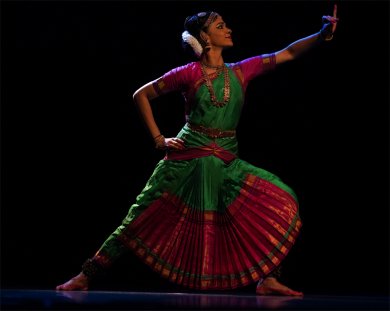 Navia Natarajan This year's Margazhi offer of 'Dance for Dance' (Dec 27-29, 2019) mounted at the Bharatiya Vidya Bhavan premises, Chennai, with the support of Kartik Fine Arts, had its curtain raiser performance in a Bharatanatyam recital by Navia Natarajan. A dancer with that concentrated stillness of internalised emotion, Navia's recital based on the larger theme of dance becoming one with that cosmic energy which can only be experienced, being beyond all form and description, was a tricky subject. Dance is all about form and to make the instrument of this body convey the idea of that formless absolute, is not easy. The dancer began with the personified deity in Uddhareka Krishna based on verses taken from Haribhaktarasmriti by Rupa Goswamy, with musical input by Rajkumar Bharati. Touching on some of Krishna's childhood feats, with the Govardhana mountain lifted on his little finger to save the people from a watery grave in the deluge springing from Indra's wrath, Krishna's appearance creates varied responses, for while he is the saviour for the just, his very presence spells death for those embracing adharma. From personified Krishna, the next item went on to the formless Absolute in the varnam in Gambheeranattai, "Amma Anandadayini," a composition of Balamuralikrishna. Here in particular, Devi is worshipped as that formless energy or nirguna, niraakaara brahman, the fire of which is the essence residing within each one of us, embodied in all the five senses. While the teermanam links accompanied by Jayashree Ramanathan's nattuvangam, had all the centralised energy with impeccable dance lines and rhythm, creating a feel of the ecstasy from vibrations and the music of that unmanifest Omkara as (akaara, ukkaara, makaara), through movements was more challenging – the dancer often taking recourse to showing the form of the Devi, with frequent fluttering hand from the centre of the torso rising upwards showing the opening out of vital cycles of energy - which apart from being repetitive did not quite catch the throb of 'Omkara'. The concluding item was woven round Karaikkal Ammaiyar wanting to become one with the Lord, urgently wanting her comely body be exchanged for a demoniac form, for the body for her had no meaning, and was only an impediment in attaining the final goal which was beyond physicality. Nandini Anand was the vocalist with Vedakrishnaram providing mridangam support and Kalaiarasan on the violin. With more introspection, Navia should be able to communicate this theme more convincingly. 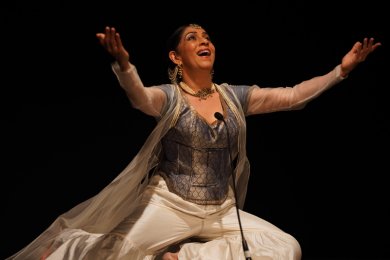 Aditi Mangaldas Kathak dancer Aditi Mangaldas presented a reworked version of an extract from her old production created in 1996, Footprints on Water. Along with the change of seasons (In this case Varsha, Sharad and Hemant), nature, earth and human emotions also reflect changes. In her typically fearless style not bound by isms, the dance showed Aditi's blend of a shloka from Kalidasa's Ritusamhara with a traditional Kathak bandish with music composed by Shubha Mudgal, with the dance interpretation abounding in typical images of the monsoons, with the rainfall, the dancing peacock, the shivering bird drenched in the rains, croaking frogs, and woman's cascading tresses reflected in water pools. Kalidasa's Ritusamhara verse again signalled the entry of Sharad when sky, trees, buds, earth are all bathed in white light in the white clouds floating like lotus buds and water sparkling. The last part of Hemant was based on delightful poetry by Jeevan Pani and poems of Hitomaro and Jeevan Pani and Haiku poems (translation by Dr. Madan Gopal Singh). Interspersed between interpretative passages were Kathak nritta bandishes at which Aditi excels, her unabashed virtuosity of chakkars and 'peir ka kaam' only too well known. Musicians were Mohit and Ashish Gangani on tabla and pakhawaj, with Faraz Ahmed providing vocal support and Ravinder Rajput providing the flute accompaniment. 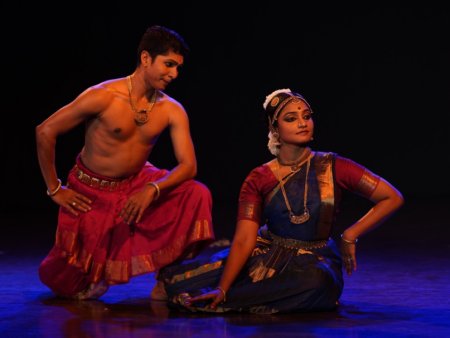 Renjith and Vijna The Bharatanatyam dancing duo Renjith Babu and Vijna Vasudevan presented what they called the Acharya Margam in praise of their guru C.V. Chandrasekhar, whose choreography marked the performance. The start with Panchadeva obeisance in ragamalika and talamalika set by music composer Hariprasad, was followed by the centrepiece comprising the varnam composition of Rangaswamy Nattuvanar "Chelamela je sevaiyya" in Natakuranji set to adi talam. The duo's presentation showed a good understanding of stage space thanks to constantly performing together. The nayika's address to the lord in this varnam questions his indifference to a devotee ever serving at his feet. Overcome with the majestic beauty of his reclining form on his bed of Adisesha on the ocean, the devotee wants to know if her/his devotion for One who saved even Draupadi, has become a burden for him ("Nannu brova neeku bharama"). Renjith is a striking dancer and while neither dancer is short on technique, the varnam as a whole sagged sans sparkle and this writer found the post-varnam phase more evocative with the padam in Kapi "Ettai irundu peshum" choreographed by Guru Chandrasekhar and presented by Vijna. The nayika chides her wayward Lord Kadir Vadivela, whose praises are sung by the whole world, for his unfaithfulness. "Ini enna uravu?" What remains of the relationship between us, she asks. Vijna's presentation had sarcasm and conviction and I felt that the dancer from here came more into her own. Renjith's rendition of the Papanasam Sivan composition in Kamas, "Idadu padam tooki aadum" portraying the dance of Nataraja, showed the dancer's equipoise. The finale was a Surdas bhajan "Bhoojat Shyam kaun to gori," the- tongue-in-cheek interaction between a young Radha and Krishna on their first meeting in Brindavan, an ideal theme for a male/female duo. 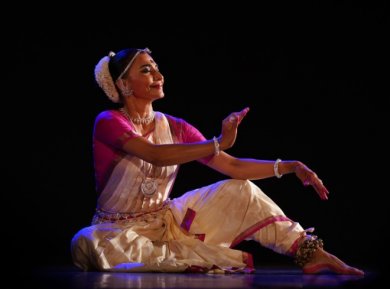 Bijayini Satpathy A packed auditorium waited to greet Bijayini Satpathy whose fame had gone ahead of her. After years of recognition as a lead dancer of the Nrityagram ensemble, she is now being seen in her latest incarnation as a solo Odissi dancer. Her recital, in choice of items, in more than one way, provided scope to highlight the genderless nature of a highly trained dancer's proficient body - with gender brought out in the moment of the dance. The first item of Shivashtakam based on Shankara's verses was based on the glory of Shiva. The ashtapadi from Jayadeva's Gita Govindam selected for the evening, "Priye charusheele" portrayed a penitent Krishna assuaging Radha's hurt and anger and declaring his love for her. The concluding item Sita Haran from Tulsidas' Ramcharit Manas, had characters who barring Sita, were male. The presentation however was by a female dancer. With her strong stage presence, immaculate technique and superb execution, Bijayini held the audience spellbound, notwithstanding the below form singer Jatin Kumar Sahu whose vocal cords sounded very tired. The sculpted perfection of the "Pannaga bhooshana', 'Jatamukuta', 'Vikata bhairava', 'trailokya natha', 'Charu Chandravatamsa', 'Trinetra', 'Panchavakra' Shiva came out with sublime power. In the ashtapadi what one found noteworthy was the dignity of Krishna not a whit lessened, despite pleading with Radha to forgive him – offering his bent head for her to keep her lotus feet on to banish the poison in his body. Every action in Sita Haran – from the fleet footed Maricha, from Lakshman's shock at Sita's words that he covets her for himself, from the sequence of Ravana abducting Sita, ending with Jatayu's valiant fight to free Sita -was powerfully brought out and very poignant moments like Sita's anguish as she realises how she has wronged Lakshman, and by not heeding him, brought this tragedy on herself "Haye Lachman tumara nahi dosa" (Lakshmana, it is not your fault). This natya production with the masterly choreography by late Kelucharan Mohapatra and music by Raghunath Panigrahi, has been performed to standing ovation, by several dancers. And Bijayini is certainly not the last to earn encomiums after presenting this. 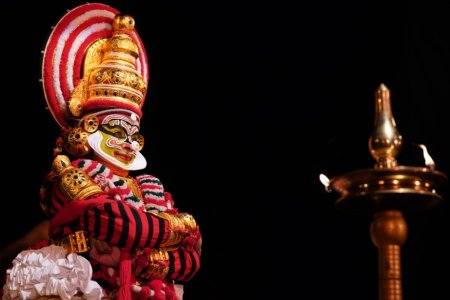 Margi Madhu On the last evening of the three day festival of Dance for Dance, Koodiyattam by Nepathya saw Himakaram, a scene from Ashokavanikankam from Saktibhadra's play Ascharyachudamani. Only an art form with the imagination of Koodiyattam could weave a whole long scene round the beauty of Sita's hair and this literal 'hair splitting' is by Ravana, lost in pining for Sita, whom he has abducted and lodged under the Shimshapa tree in Lanka. Margi Madhu Chakyar as Ravana, after a description of Sita's Panchanga, or five parts of her body, begins to contemplate on how Sita's lustrous hair has emerged winner after competing with the peacock feather, which in a dialogue with Sita's hair asserts that its own beauty far outdoes the splendour of the hair. The altercation with the feather wanting a final word of judgement from Brahma, has both parties in Brahmaloka where Brahma after one irritated final word to the feather, ignores it, lost in admiring the lustrous strands of Sita, caressing and adorning it with flowers. What seems almost ridiculous, with the hair becoming an entity in its own right, becomes great art as Margi Madhu in an oh-so-slow manner receives the hair in Satyaloka, caresses it and then accords it a ceremonial send-off! Margi Madhu's enactment of Ravana in the grip of deep desire for Sita, desire which is threatening to consume him, was powerfully brought out – clenched fists and shivering body showing how he is wracked by unrequited passion. And throughout the mood build up with the mizhavu percussion by Kalamandalam Manikantan and Nepathya Jinesh with Kalanilayam Rajan on edakka and Dr. Indu G on thalam excelled in artistry. The versatility and range in the myriad rhythmic tones of the mizhavu are astonishing. After yet another description of Sita's eyes, face, breast and feet, Ravana addresses the night moon in his fevered state of love, saying "tavakinah rasmayah vahnim vamanti" (your rays pour on me like fire and burning embers). As Kama's arrows attack him he says, "tavabalam anangasyabalam na" This is not the power of you or of Madana but, "Esha janakaduhituh" - but that of the daughter of Janaka. Every aspect of desire, the expectation, the yearning, the passion and finally the utter despair in the actor's presentation had the greatest of conviction in the actor's abhinaya. 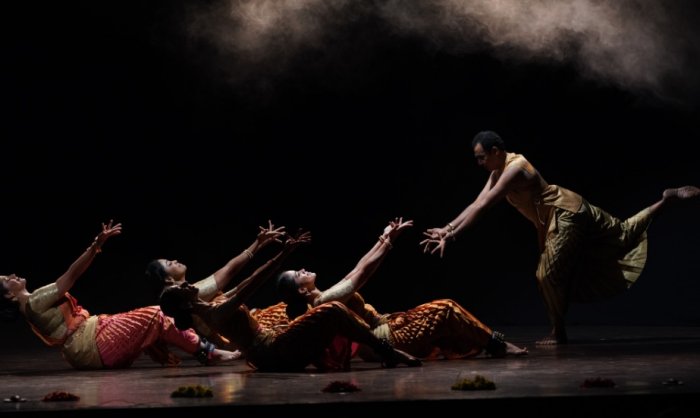 Sankhya Dance Company Lightening the taut atmosphere, with a fine group presentation in Bharatanatyam, was Vaibhav Arekar's Sankhya group, with an aesthetically designed presentation on the Seasons. Here the seasons are not so much a picture of nature but of how humans imbibe and reflect the impact of seasons in their activities. Grishma shows the to be or not to be conflict, torn between an outside world which is very different from what one feels inside. Here dance movements with the abstraction of raga music and taanum caught the mood. Monsoon, the best of the scenes, reflected pure joy of becoming one with the giggling brook or the leaf filled tree with the pregnant river flowing, "Mathwaro badal bhayore Hari ko sandesha kachu nahi layo" says Meera. Sharad was all about the hyper activity of life with the automaton of life in the city where one hardly knows where exactly one is going. There was a great deal of to and fro movement which at times became a little repetitive and too prolonged. Vasantha, the season for love, had the Ganika. If in Dharmapuri Subbarayar's "Era ra ra" in Kamas, she was inviting the lover, her life reflected the darker moments too. The opposites in life coexist for without light there is no darkness. What one liked were the extremely poetic live introductions to each scene by Vaibhav. One must commend the selection of dancers for the festival. One looks forward to next year's Kalavaahini festival in Margazhi.  Writing on the dance scene for the last forty years, Leela Venkataraman's incisive comments on performances of all dance forms, participation in dance discussions both in India and abroad, and as a regular contributor to Hindu Friday Review, journals like Sruti and Nartanam, makes her voice respected for its balanced critiquing. She is the author of several books like Indian Classical dance: Tradition in Transition, Classical Dance in India and Indian Classical dance: The Renaissance and Beyond. Post your comments Please provide your name and email id when you use the Anonymous profile in the blog to post a comment. All appropriate comments posted with name and email id in the blog will also be featured in the site. |